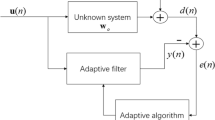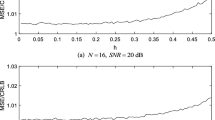Abstract
An efficient implementation for finding digitally the interpolated samples is the Farrow structure. It mimics digitally a hybrid system where a continuous-time (CT) signal is reconstructed using an analog reconstruction filter having a piecewise-polynomial impulse response. The interpolated samples are obtained by sampling reconstructed signal. This paper introduces a generalized design method for polynomial-based interpolation filters and Farrow structure. The proposed method also can be used to calculate the coefficients of Selva interpolator. In this approach, the ideal CT impulse response is truncated by using CT window functions. The obtained windowed impulse response is then approximated using the piecewise Taylor polynomial approximation. Length of the impulse response and degree of the approximating polynomial can be arbitrarily selected, and in this way the transition band width can be controlled. However, if CT fixed-window functions are used, the stopband attenuation is determined by window type and remains approximately constant with increase of length and order of the impulse response. The stopband attenuation can be controlled by using CT dynamic windows such as Kaiser window. The presented windowing design method is an effective tool for calculation of the Farrow structure coefficients, with filter performance that is comparable to the frequency domain design.








Similar content being viewed by others
References
D. Babic, Piecewise polynomial approximation based on Taylor series with efficient realization using Farrow structure, in Int. Conf. on Telecomm. in Modern Satellite, Cable and Broadcasting Services, (2009). doi:10.1109/TELSKS.2009.5339415
D. Babic, H.G. Göckler, Estimation of the length and the polynomial order of polynomial-based filters, in Int. Conf. on Sampling Theory and Applications (2009). hal.archives-ouvertes.fr:hal-00451768
D. Babic, J. Vesma, T. Saramäki, M. Renfors, Implementation of the transposed Farrow structure, in Proc. IEEE Int. Symp. Circuits and Systems (2002). doi:10.1109/ISCAS.2002.1010374
D. Babic, T. Saramäki, M. Renfors, Conversion between arbitrary sampling rates using polynomial-based interpolation filters, in Proc. 2nd Int. TICSP Workshop on Spectral Methods and Multirate Signal Process. SMMSP (2002), pp. 57–64
D. Babic, J. Vesma, T. Saramäki, M. Renfors, Implementation of the transposed Farrow structure, in Proc. IEEE Int. Symp. Circuits and Systems (2002). doi:10.1109/ISCAS.2002.1010374
R.E. Crochiere, L.R. Rabiner, Multirate Digital Signal Processing (Prentice-Hall, Englewood Cliffs, 1983)
L. Erup, F.M. Gardner, R.A. Harris, Interpolation in digital modems. Part II: Implementation and performance. IEEE Trans. Commun. 41, 998–1008 (1993)
C.W. Farrow, A continuously variable digital delay element, in Proc. IEEE Int. Symp. on Circuits and Systems (1988). doi:10.1109/ISCAS.1988.15483
A. Gotchev, J. Vesma, T. Saramäki, K. Egiazarian, Multi-scale image representations based on modified B-splines, in Proc. Int. Workshop on Spectral Techn. and Logic Design for Future Digital Systems (2000), pp. 431–452
M. Greenberg, Advanced Engineering Mathematics, 2nd edn. (Prentice Hall, New York, 1998). ISBN 0-13-321431-1
J.F. Kaiser, Nonrecursive digital filter design using the I0-sinh window function, in Proc. IEEE Symp. Circuits and Systems (1974)
T. Saramäki, Finite impulse response filter design, in Handbook for Digital Signal Processing, ed. by S.K. Mitra, J.F. Kaiser (Wiley, New York, 1993), Chap. 4
R.J. Selva, An efficient structure for the design of variable fractional delay filters based on the windowing method. IEEE Trans. Signal Process. 56, 3770–3775 (2008)
M. Unser, A. Aldroubi, M. Eden, Fast B-spline transforms for continuous image representation and interpolation. IEEE Trans. Pattern Anal. Mach. Intell. 13, 277–285 (1991)
M. Unser, A. Aldroubi, M. Eden, Polynomial spline signal approximations: filter design and asymptotic equivalence with Shannon’s sampling theorem. IEEE Trans. Inf. Theory 38, 95–103 (1992)
J. Vesma, R. Hamila, T. Saramäki, M. Renfors, Design of polynomial interpolation filters based on Taylor series, in Proc. IX European Signal Process. Conf. (1998), pp. 283–286
J. Vesma, T. Saramäki, Interpolation filters with arbitrary frequency response for all-digital receivers, in Proc. IEEE Int. Symp. on Circuits and Systems, (1996). doi:10.1109/ISCAS.1996.541788
J. Vesma, T. Saramäki, Polynomial-based interpolation filters, Part I: Filter synthesis. Circuits Syst. Signal Process. 2, 115–146 (2007)
Author information
Authors and Affiliations
Corresponding author
Rights and permissions
About this article
Cite this article
Babic, D. Windowing Design Method for Polynomial-Based Interpolation Filters. Circuits Syst Signal Process 32, 759–780 (2013). https://doi.org/10.1007/s00034-012-9486-y
Received:
Revised:
Published:
Issue Date:
DOI: https://doi.org/10.1007/s00034-012-9486-y




